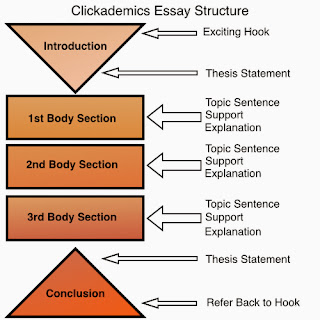 To the small group of readers unfamiliar with the five paragraph essay, it is a structure, almost a
To the small group of readers unfamiliar with the five paragraph essay, it is a structure, almost a formula, that students use to write expository essays. It begins with an introductory paragraph, followed by three body paragraphs, and ends in a concluding paragraph. Each body paragraph begins with a topic sentence and is supported with 4-6 sentences of facts and explanation. Standard school essay.
The five paragraph essay is what I used when teaching writing in my middle school English classes and is also what students use when they write using my website, Clickademics Essay Engine, which helps struggling writers through the writing process. I like it because it is a good starting point. It forces students to lay out the argument of the paper in a logical way that is easy for readers to follow. Were it not for this structure, most young writers would simply write sentences as they popped in their head. If a high school teacher told his students to avoid writing five paragraph essays, he would not receive a variety of well-written prose, he would receive a couple good essays and a whole lot of jumbled, hard-to-read text that would be far more difficult to read than a homogeneous stack of five paragraph essays.
Like all rules, the structure of the five paragraph essay was made to be broken. Once students have mastered the basic form, they can expand where needed. If three supporting details are not enough, there is room for more. If six sentences are not enough to fully explain an idea, the writer can expand on the thought, even adding another paragraph. But doesn't that mean it would be a six paragraph essay?
Now the grumpy teachers do have a point - high school students should not be writing the same five paragraph essays that they wrote in middle school. Older writers should be breaking out of the formula and making the structure fit the essays topic. But the answer is not to trash the five paragraph essay structure, it is to explicitly teach how good writers break out, how to write more without rambling, how to elegantly transition between ideas, how to write a thesis that does not clumsily list the topics of the three paragraphs.
The five paragraph essay is actually misnamed because it does not necessarily have to have five paragraphs. It is simply organized writing. There are, however, some elements that non-negotiable. Every expository essay - or speech for that matter - should have:
- A catchy introduction
- A thesis that clearly states the point of the piece
- Facts and evidence that supports the point
- Ideas laid out in a logical order
- A conclusion that gives a sense of completion
So don't hate the five paragraph essay. Just know that it is a stepping stone to mature writing. Most students just need a nudge before they can leave the safety of the structure and find their own style.
No comments:
Post a Comment
Note: Only a member of this blog may post a comment.